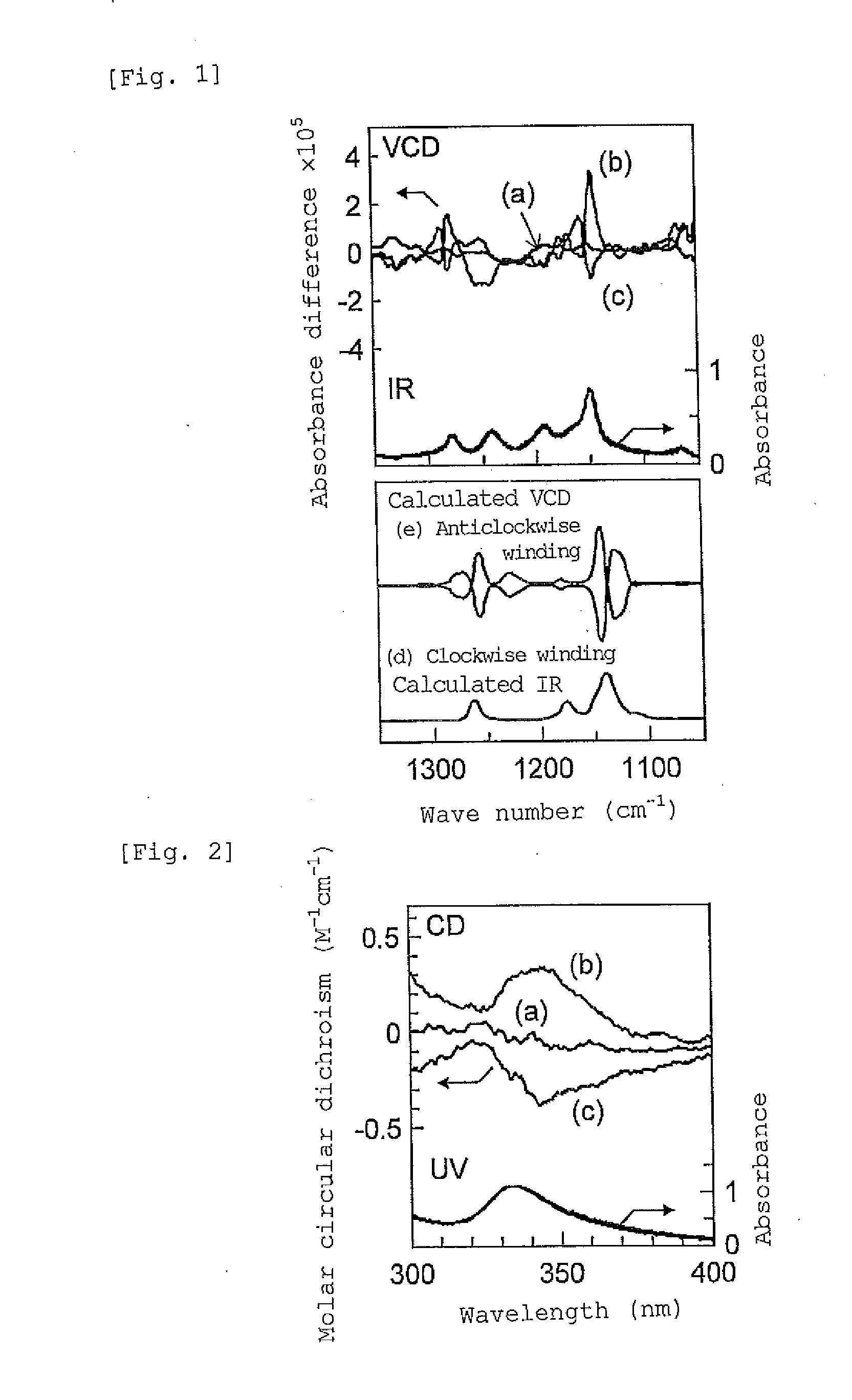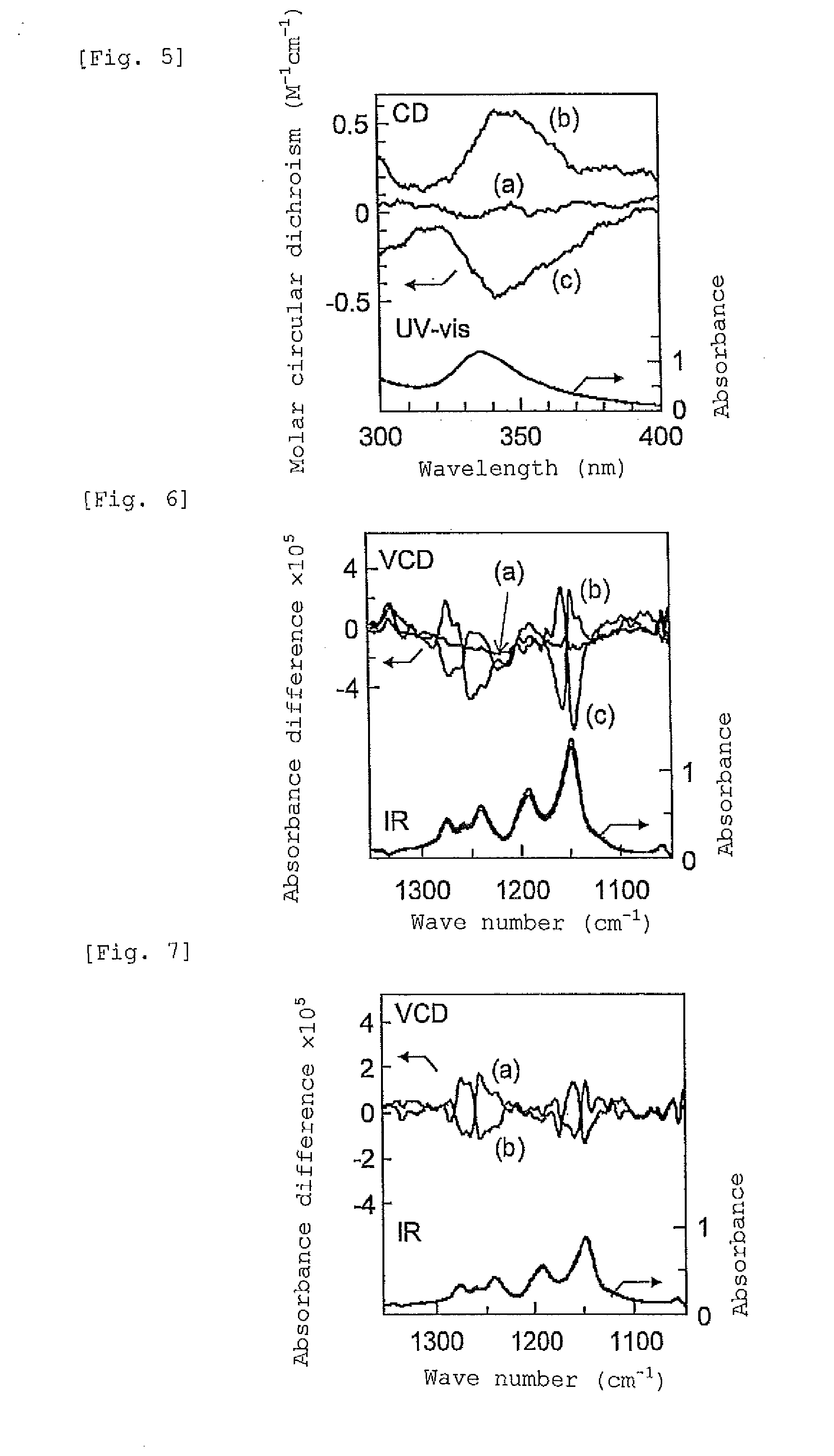Synthetic polymers controlled in spiral structure, host-guest compounds prepared by using the same, and processes for production of both
a technology of spiral structure and synthetic polymers, which is applied in the direction of special tyres, transportation and packaging, tyre parts, etc., can solve the problems of easy breakdown of spiral structure, limited to macromolecules, and easy initiation of group reactions, etc., and achieve convenient and inexpensive production, high density, and convenient production
- Summary
- Abstract
- Description
- Claims
- Application Information
AI Technical Summary
Benefits of technology
Problems solved by technology
Method used
Image
Examples
example 1
[0117]Production of Syndiotactic polymethyl methacrylate Having Unidirectionally Wound Spiral Structure Formed by 1-phenylethanol in Toluene Solvent
[0118](1) 0.5 mL of a solution prepared by mixing (R)-1-phenylethanol as a chiral compound into toluene at a ratio of 9:1 (volume fraction), was prepared. 20 mg of st-PMMA (number average molecular weight 460,000, syndiotactic triad content (rr content) 93.5%) was added to the solution, and the mixture was heated to 110° C. to obtain a uniform solution.
[0119]As the resulting solution was allowed to stand at room temperature, the solution gelled after 3 hours. The obtained gel was washed with toluene to remove the chiral compound, (R)-1-phenylethanol. The fact that (R)-1-phenylethanol could be removed, was confirmed by the 1H-NMR (Unity Inova 500 manufactured by Variant) spectra obtained before and after washing with toluene, as will be shown in Example 3 that will be described later.
[0120](2) A gel was obtained in the same manner as in (...
example 2
[0125]Production of Macromolecular Inclusion Complex (Host-Guest Compound) Composed of Syndiotactic polymethyl methacrylate Having Unidirectionally Wound Spiral Structure and Fullerene
[0126](1) To 0.5 mL of a solution prepared by mixing (R)-1-phenylethanol as a chiral compound into toluene at a ratio of 9:1 (volume fraction), 20 mg of st-PMMA (number average molecular weight 460,000, syndiotactic triad content (rr content) 93.5%) was added, and the mixture was heated to 110° C. to obtain a uniform solution. As this solution was allowed to stand at room temperature, the solution gelled after 3 hours. The obtained gel was washed with toluene to remove the chiral compound. It was confirmed by 1H-NMR that the chiral compound had been removed, similarly to the case of Example 3 that will be described later.
[0127]1 mL of a solution of fullerene C60 in toluene (2 mg / mL) was added to the obtained gel, and the mixture was stirred for 10 minutes. When the gel was precipitated by centrifugatio...
example 3
[0133]Production of Macromolecular Inclusion Complex (Host-Guest Compound) Composed of Syndiotactic polymethyl methacrylate Having Unidirectionally Wound Spiral Structure and Fullerene in One Step
[0134](1) To 0.5 mL of a solution prepared by mixing a toluene solution of fullerene C60 (fullerene concentration 2 mg / mL) and (R)-1-phenylethanol as a chiral compound at a ratio of 8:2 (volume fraction), 20 mg of st-PMMA (number average molecular weight 460,000, syndiotactic triad content (rr content) 93.5%) was added, and the mixture was heated to 110° C. to obtain a uniform solution. As the resulting solution was allowed to stand at room temperature, the solution gelled after 15 hours. The obtained gel was washed with toluene to remove the (R)-1-phenylethanol. The 1H-NMR (Unity Inova 500 manufactured by Variant) spectra obtained before and after washing with toluene are presented in FIG. 3. In FIG. 3, (a) in the upper row represents the spectrum obtained before washing, and (b) in the lo...
PUM
| Property | Measurement | Unit |
|---|---|---|
| Concentration | aaaaa | aaaaa |
| Concentration | aaaaa | aaaaa |
| Concentration | aaaaa | aaaaa |
Abstract
Description
Claims
Application Information
 Login to View More
Login to View More - R&D
- Intellectual Property
- Life Sciences
- Materials
- Tech Scout
- Unparalleled Data Quality
- Higher Quality Content
- 60% Fewer Hallucinations
Browse by: Latest US Patents, China's latest patents, Technical Efficacy Thesaurus, Application Domain, Technology Topic, Popular Technical Reports.
© 2025 PatSnap. All rights reserved.Legal|Privacy policy|Modern Slavery Act Transparency Statement|Sitemap|About US| Contact US: help@patsnap.com



